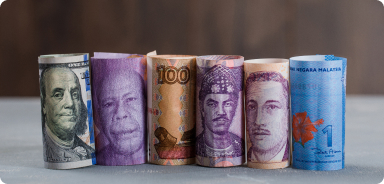-
Trade more than 80 currencies 24 hours a day, 5 days a week
-
Low spreads with EUR/USD without commissions
-
Less than 10.05 ms average execution time
-

-
Up to 3500 orders are executed per second
-
Ultra low delays from data centers
FAQs
-
Forex is the most active market in the world in terms of trading volume and the largest market in terms of value with daily transactions worth about $7 trillion. Given the international reach of the market, Forex trading takes place 24 hours a day (excluding weekends) and determines exchange rates for all world currencies.
-
Forex investors trade major and minor (not including the U.S. dollar) currency pairs, estimating when one currency might rise towards the other. The point of Forex trading involves buying one currency for another (while selling another). Traders expect to make a potential profit from selling a currency at a higher price than when it was originally purchased. A currency pair consists of a base currency and a quote currency. The exchange rate shows how much of the quoted currency is needed to buy one unit of the base currency
-
A CFD is a financial instrument that allows traders to invest in an asset class, namely currency pairs, without actually owning the underlying asset. CFD offer traders the opportunity to profit from price movements - rising or falling. It is calculated as the movement of an asset between entry and exit in a transaction, calculating only the price change without taking into account the underlying value of the asset. CFD on currency pairs works as a contract between two parties (buyer and seller). It states that the seller will pay the buyer the difference between the current value of the asset and its value at the "contract term". If the difference is negative, the buyer pays instead of the seller.
-
There are four main types of currency pairs traded by traders depending on their strategy:
Major pairs: the most actively traded pairs with more liquidity and less volatility. There are seven in total, and each of them overlaps with the US dollar: GBP/USD, EUR/USD, USD/JPY, USD/CHF, USD/CAD, NZD/USD and AUD/USD. These currency pairs account for 88% of all forex trading.
Secondary pairs (cross-currency pairs): currency pairs that do not include the US dollar. They tend to be less liquid, so they can be more volatile. This means that CFD trades on them can generate both large profits and large losses. Examples of minor currency pairs are EUR/GBP, EUR/AUD, GBP/JPY, NZD/JPY, GBP/CAD.
Exotic pairs. They usually include currencies of developing countries. Low liquidity and high volatility can lead to rapid and unpredictable price fluctuations. Examples of such currency pairs are EUR/TRY, USD/HKD, NZD/SGD, GBP/ZAR, AUD/MXN.
Regional pairs are currency pairs of specific regions, such as Scandinavia or Australia and Oceania. Examples: NOK/SEK, AUD/NZD, CNH/HKD. -
Currency rates fluctuate constantly throughout the day depending on whether one currency is in higher demand than another. Since the forex market encompasses currencies from all over the world, there are many factors that determine the direction of currency pair quotes depending on their perceived value for paying for goods and services or for investing.
